Data Standards Defined and Explained: Learn How to Create Data Standards

Data standards are the key to breaking down data silos and creating interoperability, or the ability to exchange data between disparate systems and teams.
Standards are also necessary to create data integrity, ensuring data maintains its value and meaning and is usable, consistent, and accurate.
The average enterprise today has more than 50 customer experience (CX) solutions, 21,000 app-to-people connections, and 30% annual SaaS turnover.
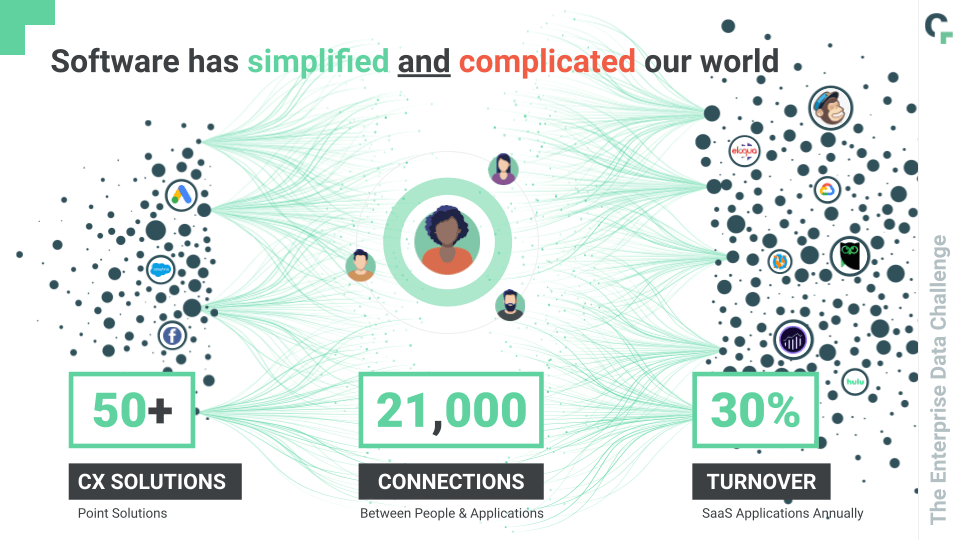
Teams struggling to collaborate and manage data through shared documents and spreadsheets in this ever-changing environment need a better approach to data in all regards, especially governance and management.
What Are Data Standards?
A data standard, or digital standard, is an assembled collection of data components that uniformly describe data according to the expectations of all data users.
Components include things like:
- The fields you want to collect
- How these relate to each other
- If the data type in a field needs to be a key, date, text, integer, part of a list, etc.
- If you have any validation rules such as needing to be unique, following a certain pattern for a date, being less than X characters, more than X digits, within a list
- Where and how these need to map to other systems
When implemented successfully, data standards will:
- Capture every workflow’s context
- Speak fluently with all your tech
- Minimize inconsistency and duplication
- Maximize usability, access, and understanding
Using digital marketing as an example, here’s a look at how data can look without standards.
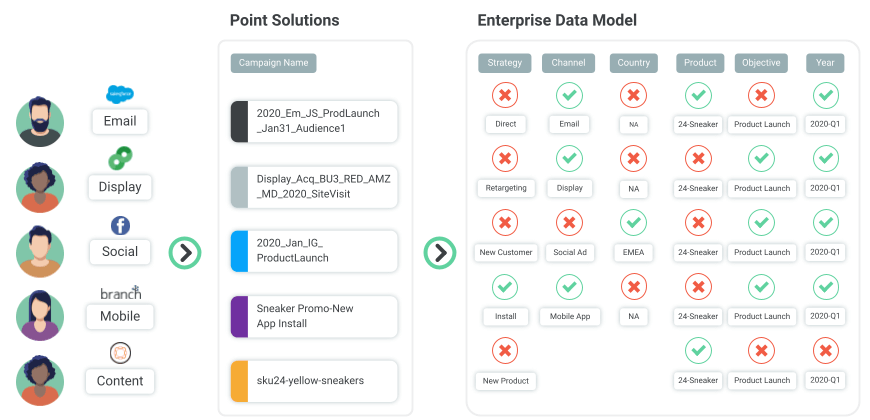
Notice how this compares data collected from various common marketing sources: email, display ads, social media, mobile marketing, and content marketing. Strategy, tracking, performance, and other data created and collected from these sources — all in the same campaign — end up in data models not only different, but lacking fields in comparison to one another.
And even if different data does track the same thing, it may not be tracking it in the same way. Something as simple as saying “24 SNEAKER” instead of “24-sneaker” might seem like small potatoes, but can actually cause major disruptions for other teams and platforms that want to use, analyze, and measure this data.
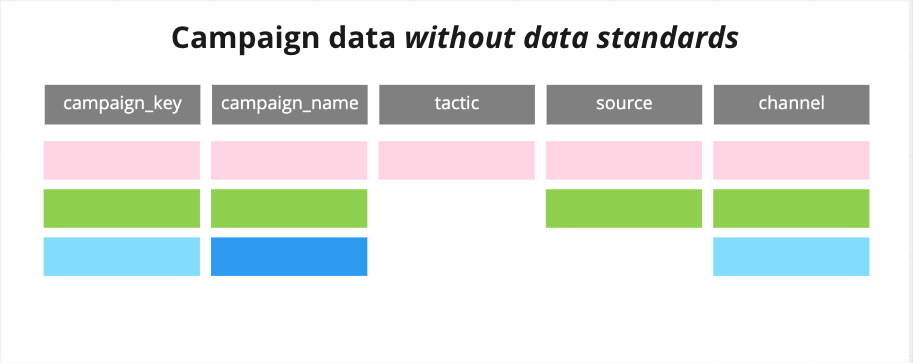
Unstandardized data is like trying to have effective conversations at the United Nations without speaking any foreign languages or even having a translator.
Here’s a look at data with standards.
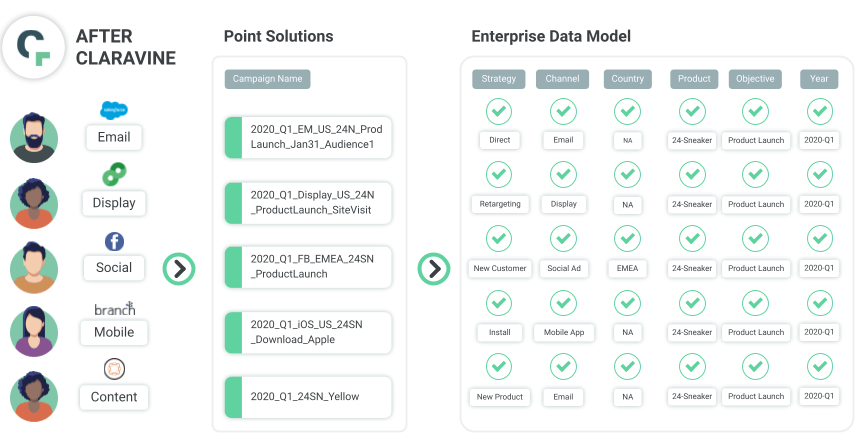
With data standards, every dataset includes the same types and breadth of information. That’s true even if a certain piece of data or entire dataset doesn’t include values for a certain field — see the “N/A” values in the Country column, for instance.
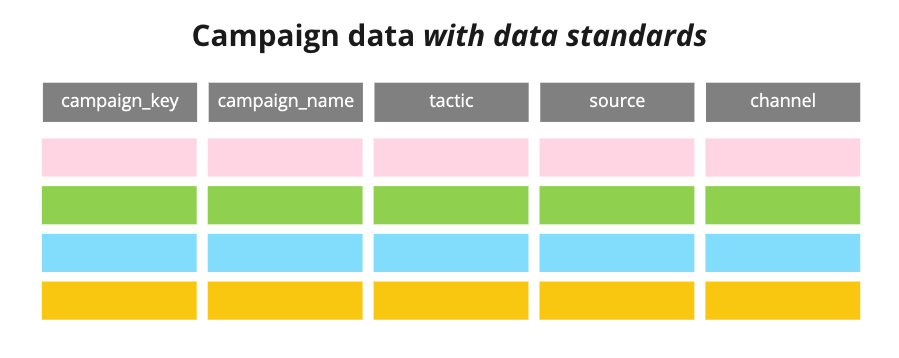 Crucially, this standardized data allows a shared data language across every team and tool. So it’s like walking into the United Nations and everyone speaking American English.
Crucially, this standardized data allows a shared data language across every team and tool. So it’s like walking into the United Nations and everyone speaking American English.
Identifying keys, or core IDs, can take this concept even further by uniting and enriching datasets, bringing them into standard and passing their metadata to other standardized sets.
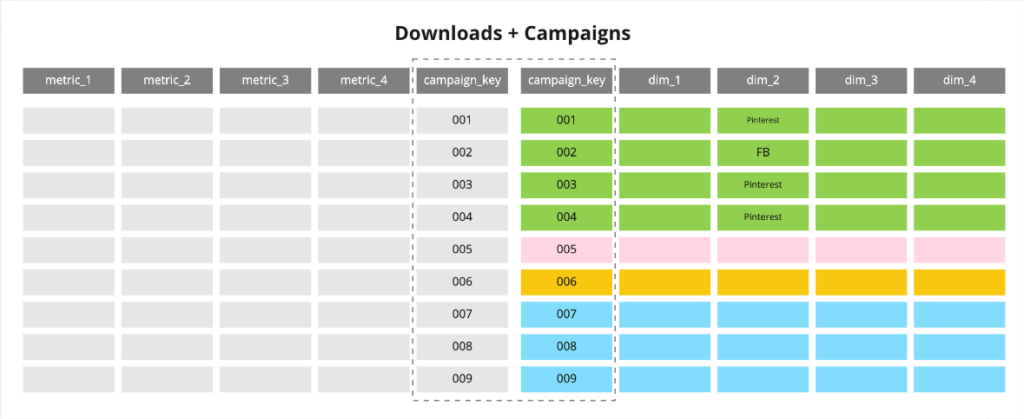 This unification allows for both broader and more accurate measurements.
This unification allows for both broader and more accurate measurements.
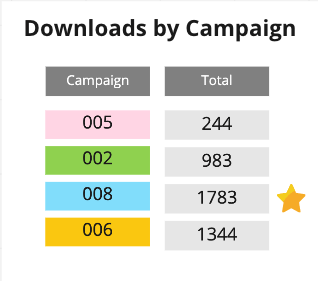
So you can analyze and draw insights from data that’s trustworthy and reliable.
That’s the overarching benefit of data standards, but let’s break out some more specific positive outcomes.
14 Benefits of Data Standards
Standards improve the quality, effectiveness, and reliability of our products and services. They do the same for enterprise data.
Here are eleven ways establishing a common digital data standard can maximize the value of your technology investment (i.e., media platforms, CX systems, data storage environments, analytics, and more):
- Improve data quality, reducing the cost of decisions made on bad data
- Deliver efficient, consistent results during retrieval
- Support metadata management, deriving maximum value from key datasets
- Enable reuse of data elements among teams for multiple purposes
- Reduce redundancy between systems, improving productivity and workflow
- Accelerate project handoffs, reducing bottlenecks through simple transitions across platforms
- Provide context so users can recognize patterns, irregularities, and commonalities
- Promote collaboration by creating a common language
- Facilitate technology changes, migrations, and upgrades with minimal disruption
- Improve measurement by aggregating 1P data for analysis and optimization
- Boost campaign performance by standardizing marketing taxonomies between marketing teams and external partners
- Deliver excellent customer experiences that meet data privacy requirements
- Better leverage machine learning or artificial intelligence (AI)
- Support business intelligence and data-driven decision making
Using the ubiquitous Adobe marketing tech stack as a use case, this video outlines the role and benefits of data standards as they permeate marketing departments.
https://www.claravine.wistia.com/medias/6y1mt0vtoi
Data Standards Examples
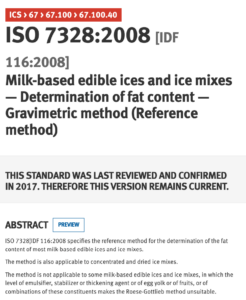 We might not realize it, but we encounter standards every day. For example, your pint of Cherry Garcia is deliciously creamy (and fattening) thanks in part to ISO 7328.
We might not realize it, but we encounter standards every day. For example, your pint of Cherry Garcia is deliciously creamy (and fattening) thanks in part to ISO 7328.
And USPS addressing standards ensure your credit card statement gets to your mailbox every month.
Examples of data standards exist everywhere — global data standards, federal and national data standards, industry data standards, niche-related standards, supply chain data standards, and more.
Whether you work in a large government agency or a boutique digital marketing firm, adhering to data standards and leveraging interoperability has countless benefits, from optimizing business processes to driving more revenue.
Let’s dive deeper into the marketing data standards example.
Marketing Data Standards
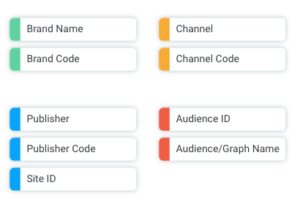 Standardizing your marketing data creates interconnectedness, which allows you to do some great things – like dynamic personalization at scale; more sophisticated analytics scenarios; clean, rich data for your machine learning and AI systems; and more.
Standardizing your marketing data creates interconnectedness, which allows you to do some great things – like dynamic personalization at scale; more sophisticated analytics scenarios; clean, rich data for your machine learning and AI systems; and more.
Consider a common campaign use case. Most organizations have a marketing taxonomy, the data language that the brand ultimately wants everyone to use. But they need to be able to put this into action, and build relationships between the most important elements. Often, the unifying fields might be the campaign ID, but could also be the creative ID, brand name, or channel.
Because of this, marketing data standards are built to capture a consistent set of fields and metadata across every data collection and creation point. This could include standards for:
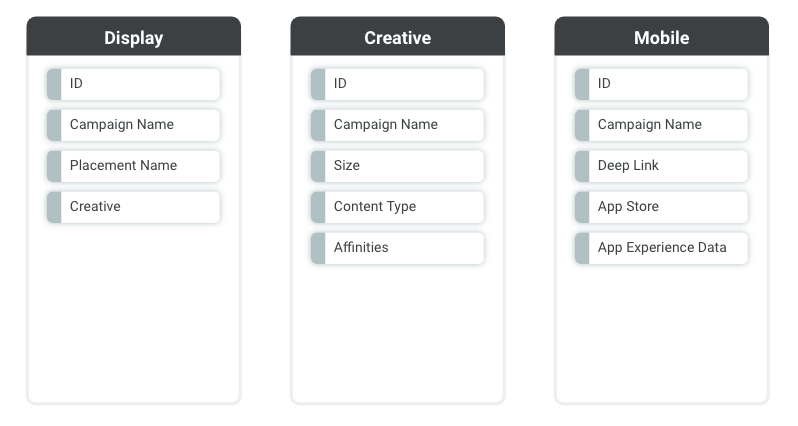
- Brand or company identifiers
- Channel
- Campaign
- Creative
- Publisher
- Audience
- Device
- Behavior
- And more…
They will also need to account for the nuanced needs of a team, region, channel or partner. So, throughout different teams and workflows, those may be broken down further by additional criteria such as placement, content type, asset size, and other attributes unique to that data’s situation – further enriching your data view. This not only provides a broader swatch of comparable, measurable data but a more accurate and complete look at this data.
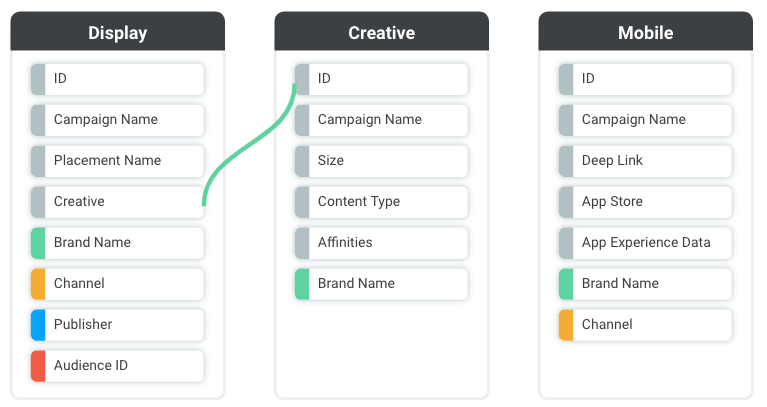
But by maintaining key attributes, you can keep data connected, even with the nuances you need. These attributes and IDs can link up data across channels, opening up new perspectives of analysis and decision-making.
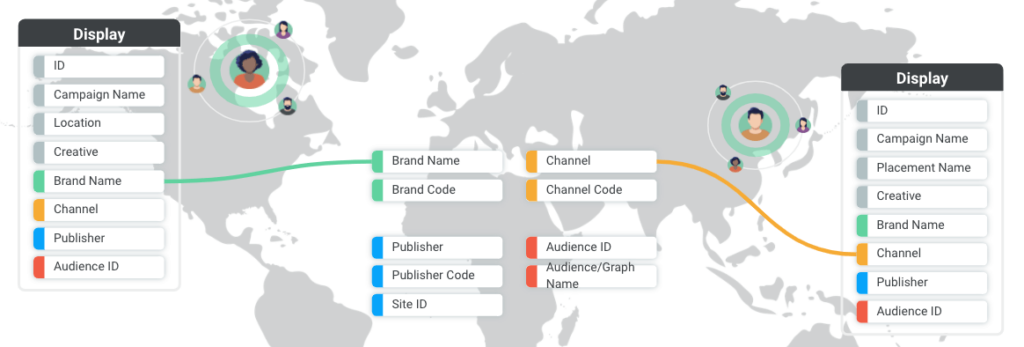
Plus, these data standards can bring together data from teams dispersed around the globe. Imagine drawing channel-level insights not just from your own region or country, but from an aggregate of international performance data.
How to Create Data Standards
Creating data standards is a process that requires cross-team collaboration, planning, documentation development, and implementation and consideration of the standards of the systems and tech you integrate with. Standards may also evolve as needs change and the organization grows.
But it’s an initiative with an extremely short runway to ROI.
Implementing data standards often starts with creating a taxonomy to define data and metatags across your key digital assets. For a detailed guide on establishing one, check out our guide, How to Build an Enterprise-grade Marketing Taxonomy.
While standards rule the web, most businesses don’t establish their own because:
- Data requirements are difficult to define, especially as business and technology needs evolve.
- Silos are prevalent, making it challenging to access or use established data formats.
- Tools don’t talk to one another, limiting data utility across the organization.
Of course, brands can leverage existing industry data standards. For example, the institutions that marketing organizations rely on — W3C, IAB, and Schema.org — created standards to facilitate a consistent digital experience across the web, mobile devices, and advertising platforms.
But that doesn’t address the need for standards for the data brands collect and generate themselves in service of their unique organizational needs.
Following these steps brings you to a more evolved level of data strategy by achieving a common language for every team, tool, and partner.
1. Determine Your Goals
Figure out what you’re trying to achieve with the data you want to capture, and then focus on the technical impact.
2. Identify Key Stakeholders
Identify each data owner, including any external partners such as agencies or vendors, so that you can make decisions about your metadata fields. Include data scientists and data analysts to identify existing unstandardized data or datasets that they have to clean up.
3. Schedule Discovery Sessions
Meet with stakeholders to discuss the data they have and the data they need, so you can create a taxonomy that serves everyone’s needs. Remember that the power of a standard depends on how well it is adopted — that’s why buy-in is paramount.
4. Define Core Business Fields
Examine the information you’ve gathered and look for areas of consistency that can serve as core business fields (i.e., a common field for “Campaign Name”) and channel-specific fields (i.e., “Keyword” for paid search).
5. Create a Data Dictionary

Establish documentation like a data dictionary for your new terminology, data elements and formats that the entire organization can leverage (or send to sales and marketing tools, content management systems, web management systems, cloud storage environments, and more).
![]()
6. Define Data Standards
Defining data standards codifies the way data is collected and stored for maximum usability. It also brings your taxonomy and dictionary to life. Data formats across your organization are different and inflexible. Realigning them to a centrally managed data language creates consistency that serves the needs of every team.
Your data standards definitions will materialize as:
- Elements like referenceable fields, patterns, powered lists, and taxonomy
- Data models for how these elements should work together
Ideally, you define and enforce your data standards in a way that they remain flexible to evolutions in your data strategy. As your organization and the digital landscape evolve, tweaks, changes, and re-classifications may be necessary to ensure your standardized data delivers the best results.
7. Apply Data Standards to Teams and Workflows
Assuming all stakeholders are on board with the proposed data standards, it’s time to implement them. This implementation will embed your data standards into the ways they already work. You’ll eliminate the silos that cause errors, inconsistencies, and bad decisions.
Teams must be trained on the data standards to embed a common understanding and enable data stewardship across the organization.
Applying data standards means addressing:
- Access: delegating access and ownership of the data standards, to both protect their integrity and allow for necessary updates by the right stakeholders.
- Interface: providing a familiar and accessible portal to the data standards
- Management: validating, searching, filtering, editing, reviewing, and creating data that adheres to standards
In summary: make it easy for people to access and use your data standards.
8. Connect and Activate Data Standards in the Tech stack
Perhaps the most difficult — yet crucial — part of launching your data standards initiative is connecting it to the plethora of tools your teams use. No matter how many dashboards, data aggregators, ETL, cleanup, or enrichment solutions you stuff into the stack, your tools are still just doing their own thing. They’re not talking to each other and they’re not even speaking the same language.
You’ll need to tap into your tools and their data flows to connect your data standards to the points of data creation. This is best accomplished with a data standards platform that has pre-built integrations that account for the ever-changing requirements of these solutions. Otherwise, it’s a nearly impossible manual endeavor.
But a dedicated data standards tool can bring the essentials:
- No-code connectors: applying standards to data coming in, going out, or moving back and forth between tools
- Field mapping: aligning datasets from disparate sources into common fields for consistency and enrichment
- Public API: opening your data standards to new tech, teams, and partners
- Import/export: loading and extracting flat files for flexible approaches
Sidebar: What About Open Standards for Data?
There are several definitions of “open standards,” each emphasizing a particular aspect of openness, such as the availability of the standard, the transparency of the creation process, and ownership of the standard’s rights. But generally speaking, open standards are IT and digital industry-accepted principles to ensure interoperability exists between hardware and software products.
In addition, open standards can be freely adopted, implemented, and updated (i.e., SQL, PDF, and HTML).
According to the World Wide Web Consortium (W3C), a standard must meet the following requirements to earn the distinction of being an “open standard.”
- Transparency: The process, technical discussions, and meeting minutes are public and accessible.
- Relevance: Updates are initiated according to market needs; standards are available in multiple languages.
- Openness: Participation is open to everyone on a worldwide scale.
- Fairness and consensus: Processes are impartial and guaranteed to be fair.
- Availability: Access to the standard is free from development through release.
- Maintenance: Testing and maintenance of standards is ongoing and collaborative.
In practice, an open standard has different interpretations. Small commercial consortia design some. Others are developed through open and inclusive processes. Regulators impose specific standards, while others are voluntary.
A single organization’s free and widely used specification could also be called an open standard.
Open Source vs Open Standards
Open standards shouldn’t be confused with open source, which refers to software that is free for anyone to use, update, and share.
An example of open source is OpenStreetMap (OSM), a collaborative project to create a free, editable world map. Anyone with a free account can copy, distribute, adapt, and transmit OSM data so long as they properly credit OSM and its contributors. It is one of many alternatives to non-open-source data types like Google Maps.
Open standards and open source technology enable interoperability, innovation, and choice. They’re essential in the data communications industry, where the interoperability of the cloud fuels innovation and new revenue sources necessary to stay competitive.
Data Strategy is Business Strategy
Insufficient or missing data standards lead to poor data quality, a problem that already costs the average organization $15M a year. And it will likely get worse with the rise of big data, SaaS sprawl, and technology advancements — not to mention data privacy laws and the deprecation of third-party cookies and device-level IDs.
“Business as usual” or operating without data standards isn’t sustainable, especially if your competitors are digitally savvy.
Look to the increasingly ubiquitous role of the chief data officer (CDO). They’re being tasked with transforming data into the organization’s most valuable asset and using data to drive business outcomes.
Their responsibilities can span data governance, operations, digital innovation, business analytics, marketing data, and more. According to a NewVantage Partners 2022 survey, 74% had appointed a CDO role or similar, indicating a shift in the approach to data.
Data Standards Enable Agile Connections Across Your Stack
Establishing your own unique data standards and taxonomies will achieve the interoperability needed to gain a competitive advantage. It’s not an easy process, so it’s understandable if you’ve been putting it off. However, many of your savvy digital-first competitors have likely embraced data standards already.
The time is now to create a common data language and improve your enterprise’s data integrity.
If you stall, the inevitable consequences will only compound as the world becomes increasingly digital. Imagine building a house — would you wait until the house is finished before installing electrical wiring in the walls?
The proliferation of software, especially cloud-based applications, exposes another reason digital data standards are sorely needed — to ensure interoperability.
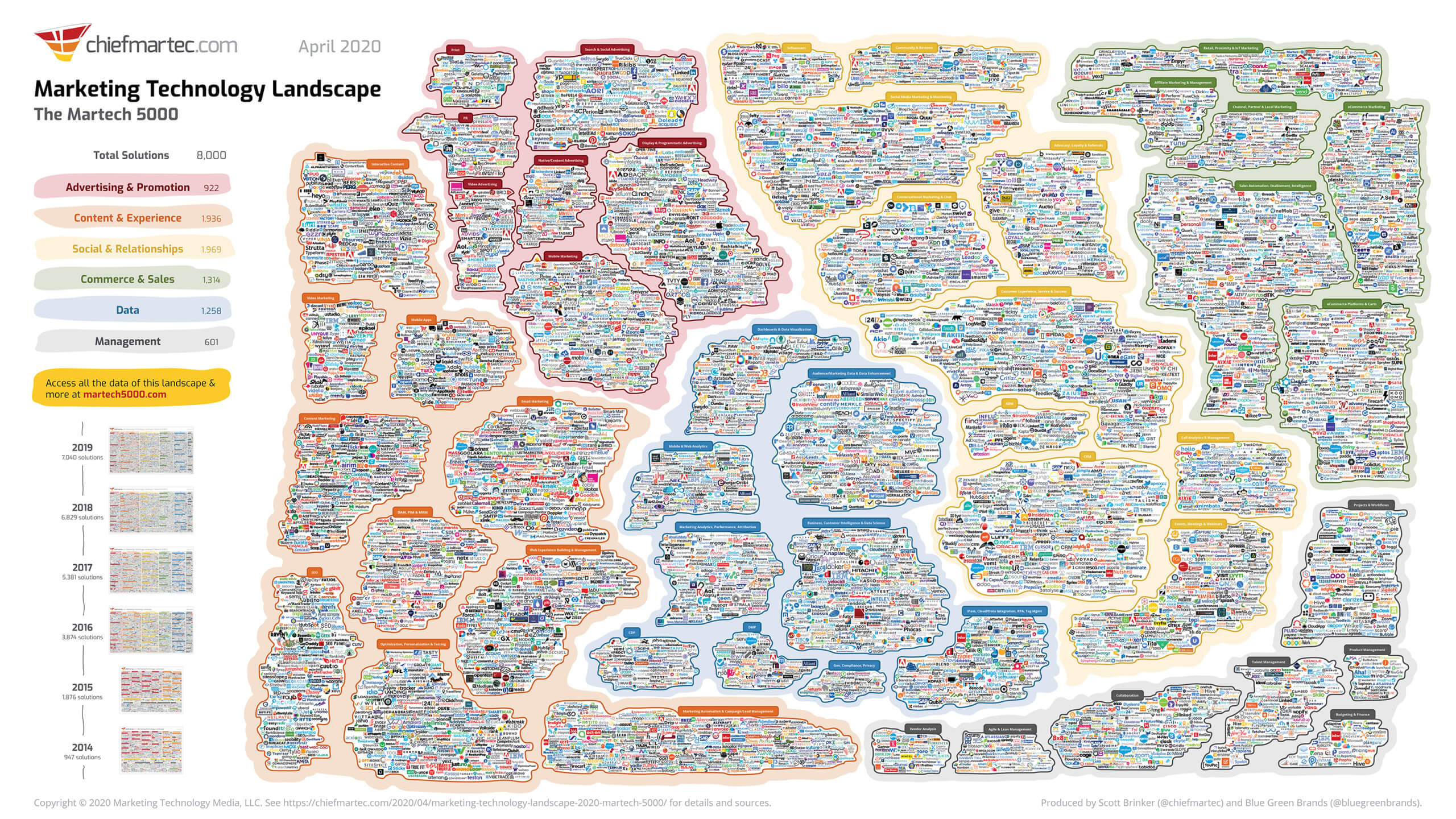
The widely cited Marketing Technology Landscape Supergraphic sheds light on the scope of the problem from a Markops perspective, estimating there are at least 10,000 active Martech solutions available today. Data standards are required to develop a best-in-class technological stack independent of vendors because there is no single platform that “does it all.” Finance, human resources, and sales technology are experiencing similar growth and are facing the same challenges — which are exacerbated by your bad marketing data.
Then there’s the sheer volume of data created by consumer behavior and media consumption and the unlimited outlets and channels delivering content, experiences, and commerce. Each consumer interaction generates a digital component, leading to more and more data that brands must manage.
Organizations must implement a variety of digital standards, including business data standards, CX standards, and marketing data standards, in order to. Adopting standards improves overall data quality and data integrity, which are essential for sound data-driven decision-making.
